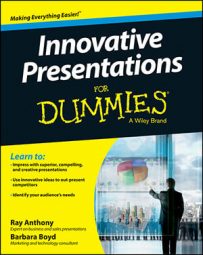A low-tech visual for innovative presentations that still has a place in today’s digital world is the flip chart. Flip charts continue to be excellent presentation media, if used effectively in groups of 25 people or fewer. A flip chart is simple, does not require electricity, and is reliable, low-cost, and easy to use.
Like presentation boards used in addition to your electronic presentation, a flip chart adds welcome variety and spontaneity and can offer a bit of professional theatrics that nicely complement your other visuals.
One presenter, who focuses on performing in a subdued, showman style, often uses a flip chart in addition to projected visuals for sales presentations to smaller groups. Purposefully moving his focus between projected visuals and a flip chart, he breaks the potentially fading attention span of his prospects and reawakens it by having them wondering what he’s going to write or show on the flip chart.
He knows exactly when and how to use the flip chart to give his presentation a unique flavor and flair. He transitions from showing visuals to writing on the flip chart. He writes what he calls, “really important numbers” about financial returns on investment from his products on the flip chart, thereby focusing the audience’s interest on those numbers.
Another creative technique an account manger for a printing company employs that impresses her audiences is to use an illustration showing the major components of her company’s 3-D printer. She prepares ahead of time by projecting that graphic onto a blank page of the flip chart and then sketches the entire outline of it with a very light pencil that only she can see from up close on the page.
During a key point in her sales pitch, she tells her group that she will quickly draw the key parts of the printer and explain how each one works to produce a product prototype in less than a minute. Using three different color markers, she quickly traces over the light pencil outline to create an almost perfectly drawn illustration — explaining each part of the illustration as she draws it.
Not seeing the pencil lines guiding her, audiences are duly impressed with her ability using this clever approach. Even if they did see the light outline, the smooth and seamless way she draws and talks while still maintaining eye contact with the group is indeed captivating.
Here are some helpful tips for making the most of your flip charts:
Write only five to seven words per line using printed letters two or three inches high with your title line four inches high. Keep to a maximum of about six lines per page.
Try to avoid using all capital letters, with the exception of titles or few words in very large print. A mix of upper- and lowercase letters is easier to read.
Flip chart pads are sold in plain white or with thin grid lines on them. Grid lines make printing and aligning words and drawing straight lines and shapes easier.
Use only the top two-thirds of a flip chart page. And either leave blank pages between to avoid bleed or see through or staple every two pages together to make turning them easier.
Lightly write your text in pencil before using markers. This lets you make any adjustments with text spacing and diagrams you draw. Also consider writing notes on the page with light pencil to help you remember key points or numbers.
Place your flip chart where it can be seen by every person in the group and, if necessary, arrange seats so that the person farthest from your chart can read the smallest lettering or figures.
When you finish writing on the pad or finish showing something, flip to a new blank page to keep your audience focused on your presentation.
To draw perfect circles on a page, use a large-diameter plastic bowl, lid, or a special flip-chart compass.
Use dark-colored (black, blue, brown), wide, chisel-tip markers to print or draw in bold ways easily seen by everyone. Use red and green markers to highlight areas, give contrast (to distinguish types of information), and to add accent and variety to your text or drawings. Avoid using orange, pink, yellow, or light colors that are difficult to see.
Write or draw on the pad, then turn around to face the audience and talk to them. Avoid talking to the flip chart with your back to the audience for extended periods of time.

